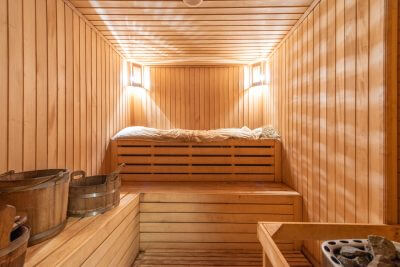
Sauna vs. Steam Room: Comparing the Heat Therapy Experience
Dry Heat in a Wood-Lined Room
- Typically, 160-200°F (71-93°C).
- Low humidity (10-20%).
- Promotes relaxation and muscle recovery.
- Good for dry skin and respiratory relief.
Moist Heat in an Enclosed Space
- Typically, 110-120°F (43-49°C).
- High humidity (100%).
- Helps with respiratory issues and skin hydration.
- Creates a wet, soothing environment.
Growing Interest in Sauna Steam Therapy
Heat therapy is experiencing a surge in popularity, with a growing interest in its various forms such as saunas, steam baths, and hot yoga. People are increasingly turning to these heat-based treatments for their numerous benefits, which include relaxation, pain relief, improved circulation, and enhanced well-being. This trend reflects a broader emphasis on stress reduction and self-care in today’s fast-paced world, as individuals seek holistic approaches to health and mental wellness.
Understanding Saunas
A Tradition of Dry Heat
A sauna is a room designed for high-temperature, low-humidity heat sessions, promoting relaxation and perspiration. Originating in Finland, saunas were traditionally heated by stones or electric stoves and are used for leisure, well-being, and detoxification. They’re known for their cultural significance in Finland and have evolved into various types, including dry saunas, steam rooms, and infrared saunas, enjoyed worldwide for relaxation and health benefits.
The defining characteristic of a traditional sauna is its low humidity. While the temperature inside the sauna can get quite high, often reaching between 160 to 200 degrees Fahrenheit (70 to 90 degrees Celsius), the humidity level remains relatively low, typically below 20%. This results in a “dry” heat, meaning there is very little moisture in the air.
Sauna-goers sit or lie down in this hot, dry environment, and their bodies start to sweat as a natural response to the high temperature. This sweating helps in the process of detoxification and relaxation. Some people may choose to sprinkle water on the heated stones to create a burst of steam, temporarily increasing humidity and intensifying the experience, but the core characteristic of a traditional sauna is its dry heat.
Saunas offer several benefits, including:
- Improved Circulation: Sauna heat causes blood vessels to dilate, which can enhance blood flow and circulation, potentially benefiting cardiovascular health.
- Relaxation: The heat and environment promote relaxation, reduce stress, and help alleviate muscle tension, contributing to an overall sense of well-being.
- Detoxification: Sweating in a sauna can aid in the elimination of toxins from the body through perspiration.
- Skin Health: The heat can open up pores and cleanse the skin, potentially improving its appearance and health.
- Pain Relief: Saunas may help alleviate muscle and joint pain, making them beneficial for those with certain medical conditions.
- Respiratory Benefits: The warm, dry air can ease breathing for some individuals with respiratory issues.
- Social and Cultural Enjoyment: Saunas provide a communal and cultural experience, often fostering a sense of togetherness and relaxation.
Exploring Steam Rooms
A steam room is an enclosed space commonly made with glass enclosures that provide a relaxing and therapeutic experience through high humidity and steam. Unlike saunas, which use dry heat, steam rooms use moist heat created by boiling water. They offer relaxation, muscle tension relief, skin pore opening, and potential respiratory benefits. They are commonly found in spas and health clubs, providing a place to unwind and de-stress. However, not everyone may be suitable for steam rooms, so consulting a healthcare professional is advisable, especially if you have health concerns.
In a steam room, the environment is characterized by high humidity and moist conditions. This is achieved by boiling water and releasing the resulting steam into the enclosed space. The warm, moist air inside the room can have several effects on the body:
- High Humidity: Steam rooms typically maintain humidity levels close to 100%, creating a thick, humid atmosphere. This high humidity can make you sweat profusely and open up your pores.
- Moist Heat: The heat in a steam room is moist and gentle on the skin, in contrast to the dry heat of a sauna. The warm, moist air can help soothe muscles, as well as potentially provide relief from respiratory congestion and promote relaxation.
- Sweating: The humid conditions encourage your body to sweat, which is a natural way of cooling down. This sweating can help flush toxins from your body and cleanse your skin.
- Respiratory Benefits: The moist heat may temporarily relieve symptoms of respiratory conditions like congestion or allergies. Inhaling the warm, humid air can help soothe and open up airways.
Steam Rooms offer several benefits, including:
- Skin Hydration: Steam rooms are known for their ability to hydrate the skin due to the high humidity. This can be especially beneficial for individuals with dry skin.
- Respiratory Relief: Steam rooms can provide temporary relief for those with respiratory issues, as the moist, warm air can help open up airways.
- Stress Reduction: The soothing, enveloping environment of a steam room can aid in stress reduction and relaxation.
- Detoxification: Like saunas, steam rooms also promote detoxification through sweating.
- Muscle Tension Relief: The moist heat in a steam room can help relax and soothe tense muscles, contributing to an overall sense of well-being.
- Skin Pore Cleansing: Steam rooms are known for their ability to open up and cleanse skin pores, potentially improving skin health.
Saunas and steam rooms are both popular choices for relaxation and promoting wellness, but they differ in several key aspects:
Heat Source:
- Sauna: Saunas use dry heat, typically generated by heating rocks or an electric heater. This dry heat can reach higher temperatures, often between 160°F and 200°F (71°C to 93°C).
- Steam Room: Steam rooms produce moist heat by generating steam from boiling water. The temperature in a steam room is lower than in a sauna, usually around 100°F to 120°F (38°C to 50°C).
Humidity:
- Sauna: Saunas have low humidity levels, typically around 10% to 20%. The air is dry, making it easier to breathe, but it can be harsh on the skin and respiratory system.
- Steam Room: Steam rooms have high humidity levels, often near 100%. The moist air can feel gentler on the respiratory system but may be less comfortable for some people.
Method of Heat Transmission:
- Sauna: In a sauna, heat is transferred through conduction, as the hot benches and walls warm your body directly.
- Steam Room: In a steam room, heat is transferred through convection as warm, moist air envelops your body.
Effects on Skin:
- Sauna: Saunas can be drying to the skin due to the low humidity, potentially leading to dehydration. However, the dry heat can help open pores and cleanse the skin.
- Steam Room: Steam rooms are hydrating for the skin because of the high humidity, making them a better choice if you want to moisturize your skin. The moist air can also help clear pores.
Respiratory Benefits:
- Sauna: Saunas can be harsh on the respiratory system for some people due to the dry air and high temperatures. However, they may help with respiratory issues in others by providing relief from congestion.
- Steam Room: Steam rooms are generally better for respiratory relief because of the moist, warm air. They can help open up airways and ease breathing, making them a preferred choice for individuals with respiratory conditions.
Sensations and Experience:
- Sauna: Saunas offer a dry, intense heat that promotes sweating and a feeling of deep relaxation. The heat is often described as a “dry heat.”
- Steam Room: Steam rooms provide a more humid and milder environment, with less intense heat. The experience is often described as soothing and enveloping.
Construction and Materials:
- Sauna: Saunas are typically constructed with wood and have wooden benches and walls. They are designed to withstand high temperatures.
- Steam Room: Steam rooms are often tiled to handle the high humidity levels, and they may have non-wooden benches.
Conclusion
In the end, whether you choose a sauna or a steam room, your decision should align with your personal preferences and health considerations. Some individuals enjoy alternating between the two for a well-rounded relaxation and wellness experience. It’s essential to stay hydrated, limit your time in high-heat environments, and consult with a healthcare professional if you have any underlying health concerns.
Considerations for Saunas:
- Use caution with cardiovascular issues.
- Stay hydrated and avoid excessive heat exposure.
Considerations for Steam Rooms:
- Caution for respiratory ailments; consult a healthcare provider.
- Maintain hydration.
- Be aware of skin sensitivities and pregnancy.
It’s essential for individuals with specific health conditions to consult with a healthcare provider before using saunas or steam rooms, and to respect recommended time limits and their body’s responses to heat therapies for a safe experience.
Explore our Amazon Store
Leave a comment


Social Links